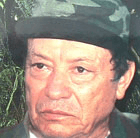Manuel Marulanda
Pedro Antonio Marín Marín (May 13, 1930 [disputed][2] – March 26, 2008), known by his "nom de guerre" Manuel Marulanda Vélez, was the main leader of the Communist FARC-EP ("Fuerzas Armadas Revolucionarias de Colombia – Ejército del Pueblo"). Marulanda was born in a coffee-growing region of west-central Colombia in the Quindío Department, to a peasant family politically aligned with the Liberal Party during conflicts in the 1940s and 1950s.
Pedro Antonio Marín | |
|---|---|
 | |
| Nickname(s) | Manuel Marulanda Vélez Tirofijo |
| Born | May 13, 1930 Génova, Quindío Colombia |
| Died | March 26, 2008 (aged 77) Meta Department, Colombia[1] |
| Allegiance | Revolutionary Armed Forces of Colombia (FARC) |
| Rank | Secretariat member, Chief of the Revolutionary Armed Forces of Colombia |
| Unit | Southern Bloc |
| Battles/wars | Colombian armed conflict |
Marulanda was nicknamed "Tirofijo" (Spanish: Surefire or Sureshot) by his comrades, apparently because of a reputed ability to accurately aim firearms.
Marulanda himself changed his political and ideological inclinations to the Communist Party (PCC) during "La Violencia" (roughly 1948 to 1958) that followed the assassination of the Liberal Party's leader Jorge Eliécer Gaitán.
In March 2006, Alberto Gonzales, the Attorney General of the United States, announced in conjunction with Drug Enforcement Administration and United States Department of Justice officials that the US State Department had placed a $5 million reward on Tirofijo's head, or for information leading to his capture.[3] But "Marulanda" was never apprehended, and died of a heart attack on March 26, 2008. He was replaced as commander-in-chief by Alfonso Cano.[4]
Early armed activities
Marulanda and members of his family, like many Liberal peasants, rose up in arms not long after they heard the news about the death of Jorge Eliecer Gaitan.
Eventually, Marulanda split with some of his relatives and became part of a column of guerrilla fighters that came under the influence of the Communist Party of Colombia, which developed a more proactive role in the fighting, executing more raids and offensive operations. He took on the name "Manuel Marulanda" in honor of a murdered union leader. Marulanda eventually met and befriended Luis Morantes, also known as Jacobo Arenas, a PCC political cadre sent to the rural areas by the central party structure.
Members of this group later settled in an area known as Marquetalia towards the end of "La Violencia", keeping their weapons. They distrusted the Colombian Army and government even after a 1953 coup led by General Gustavo Rojas against Conservative president Laureano Gómez. Rojas had offered an amnesty that was accepted by most Liberal irregular fighters nationwide, but reputedly the murder of a few demobilized individuals made Marulanda, his rural comrades and his PCC superiors in the cities uneasy.
After the fall of Rojas in 1957 and the signing of the National Front agreement in 1958 between Colombia's two main parties, self-sufficient armed enclaves, such as the so-called "independent republics" and in particular a supposed "Marquetalia Republic", were considered dangerous by the new government. Pressure from Conservative members of Congress and from the United States led to a Colombian Army attack on Marquetalia, which was eventually overrun during what was termed "Operation Marquetalia" in May 1964.
Formation of the FARC
The Colombian Army's attack was mostly ineffective, though it did scatter the guerrillas, and most of the survivors reunited elsewhere and later became part of the "Bloque Sur" (Southern Bloc) guerrilla group on 27 May 1964, a precursor to the official foundation of the FARC in 1966. Marulanda and Jacobo Arenas soon established themselves as the main leaders of the new guerrilla group.
Death
Marulanda died of a heart attack on March 26, 2008. The news was first brought by Colombian magazine Revista Semana on May 24, 2008, that cited Defense Minister Juan Manuel Santos saying Marulanda died. The minister claimed he had learned this from a reliable informant within FARC. He also told the magazine that three bombing raids had targeted the rebel chief around the date in question.[5][6] A press statement released by the Colombian Ministry of Defense on May 24 stated that Marulanda died on March 26, 2008, at 18:30 hours (UTC 13:30).[7] On May 25 in a video released to channel teleSUR, Timoleón Jiménez, aka Timochenko, another member of the Central High Command of the FARC, confirmed the death as heart failure.[4][8]
See also
- The World's 10 Most Wanted
References
- "FARC Confirma Muerte de Marulanda". Crónica Digital (in Spanish). 25 May 2008. Archived from the original on 17 November 2015. Retrieved 17 June 2014.
- (in Spanish) El Mundo: El viajo guerrillero y su delfin
- United States Department of State : US Department of State - Rewards
- "FARC confirm death of 'Manuel Marulanda'". Colombia Reports. May 25, 2008.
- "Articulo OnLine "Tirofijo está muerto"". Archived from the original on 2010-12-03. Retrieved 2018-07-24.
- "'Manuel Marulanda' is dead, says Minister of Defense". Colombia Reports. May 24, 2008.
- "Army confirms death 'Manuel Marulanda'". Colombia Reports. May 24, 2008.
- "'Las FARC confirman la muerte de Manuel Marulanda". Noticias 24. May 25, 2008. Archived from the original on 2008-05-28. Retrieved 2018-09-06.
- Diario de la resistencia de Marquetalia, Jacobo Arenas, Ediciones Abejón Mono, 1972 (Espanol)
External links
- Colombia's Rebel Patriarch Is Dead by Tim Padgett, Time Magazine, May 25, 2008
- Documentary: 50 years of Guerrilla
- Manuel Marulanda, Cuadernos de Campaňa (1953)